Audit Risk Factors in Planning the Audit Engagement
VerifiedAdded on 2023/04/03
|14
|2518
|148
AI Summary
The report aims at assessing and evaluating the risk factors in the process of planning the audit engagement from the viewpoint of the auditor. For this analysis, we have selected a company listed in the ASX namely Southern Cross Media Group Limited. The company is a pioneer in media companies in Australia which deals in free-to-air commercial radio, television and online services all over Australia.
Contribute Materials
Your contribution can guide someone’s learning journey. Share your
documents today.
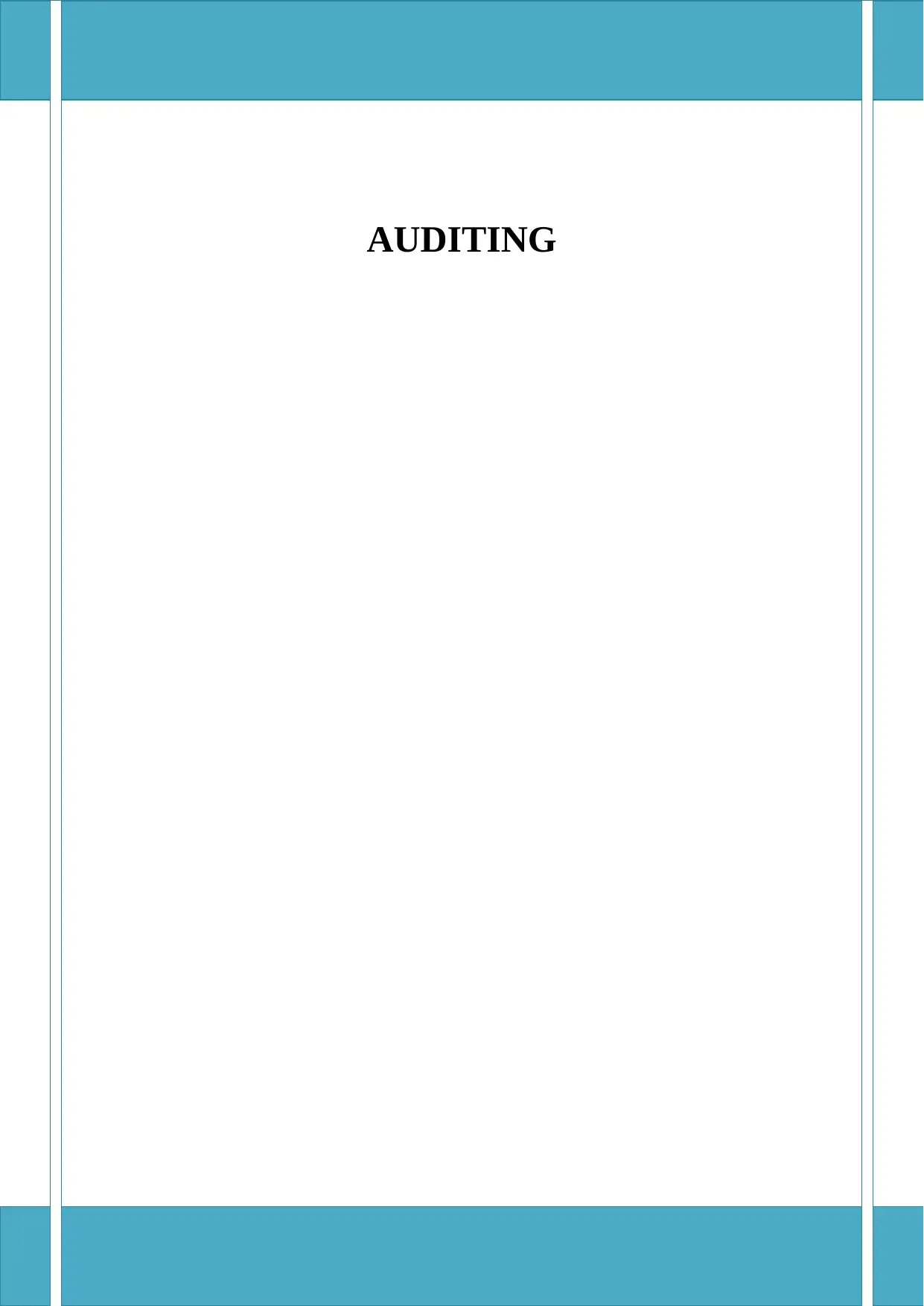
AUDITING
Secure Best Marks with AI Grader
Need help grading? Try our AI Grader for instant feedback on your assignments.
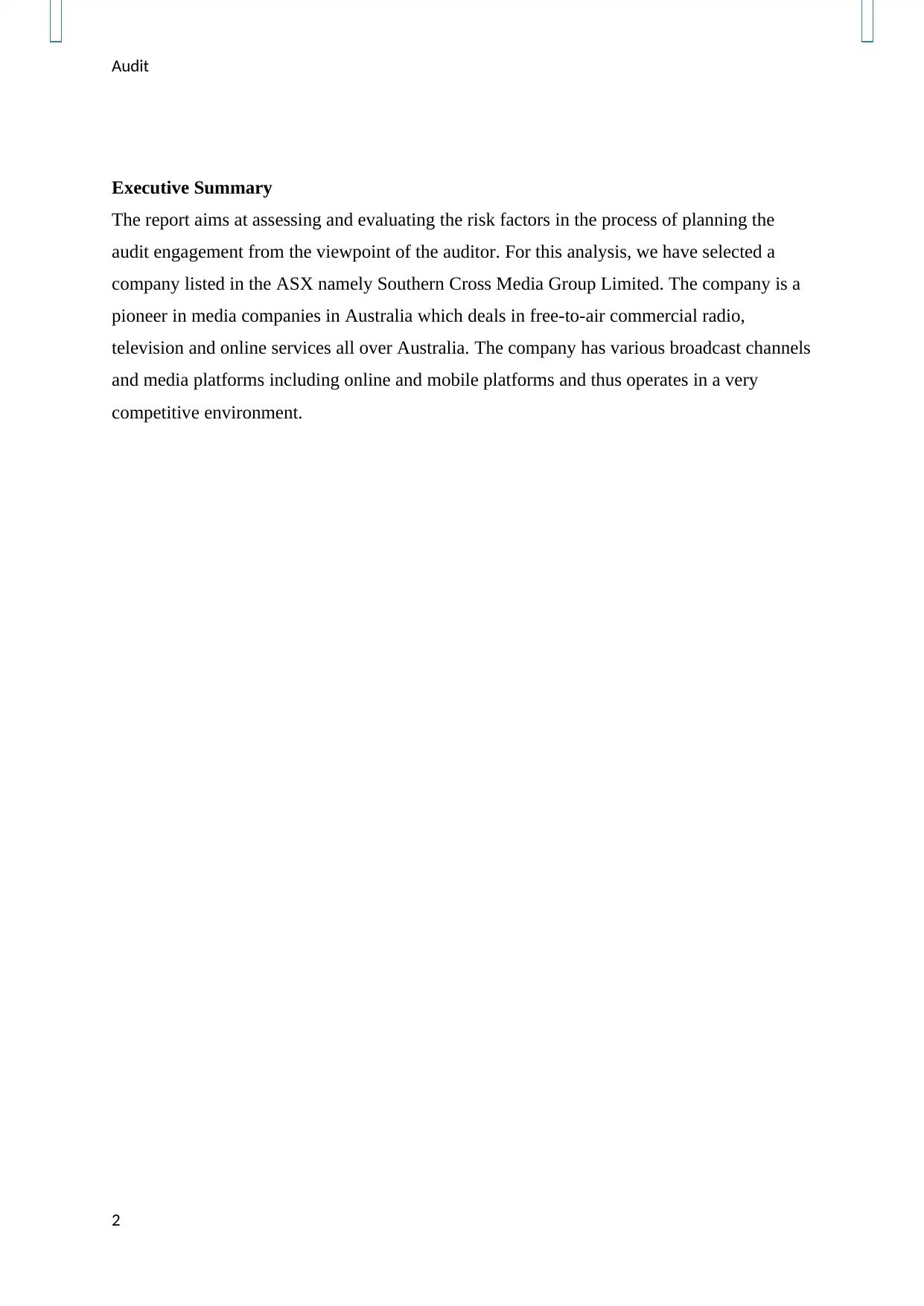
Audit
Executive Summary
The report aims at assessing and evaluating the risk factors in the process of planning the
audit engagement from the viewpoint of the auditor. For this analysis, we have selected a
company listed in the ASX namely Southern Cross Media Group Limited. The company is a
pioneer in media companies in Australia which deals in free-to-air commercial radio,
television and online services all over Australia. The company has various broadcast channels
and media platforms including online and mobile platforms and thus operates in a very
competitive environment.
2
Executive Summary
The report aims at assessing and evaluating the risk factors in the process of planning the
audit engagement from the viewpoint of the auditor. For this analysis, we have selected a
company listed in the ASX namely Southern Cross Media Group Limited. The company is a
pioneer in media companies in Australia which deals in free-to-air commercial radio,
television and online services all over Australia. The company has various broadcast channels
and media platforms including online and mobile platforms and thus operates in a very
competitive environment.
2
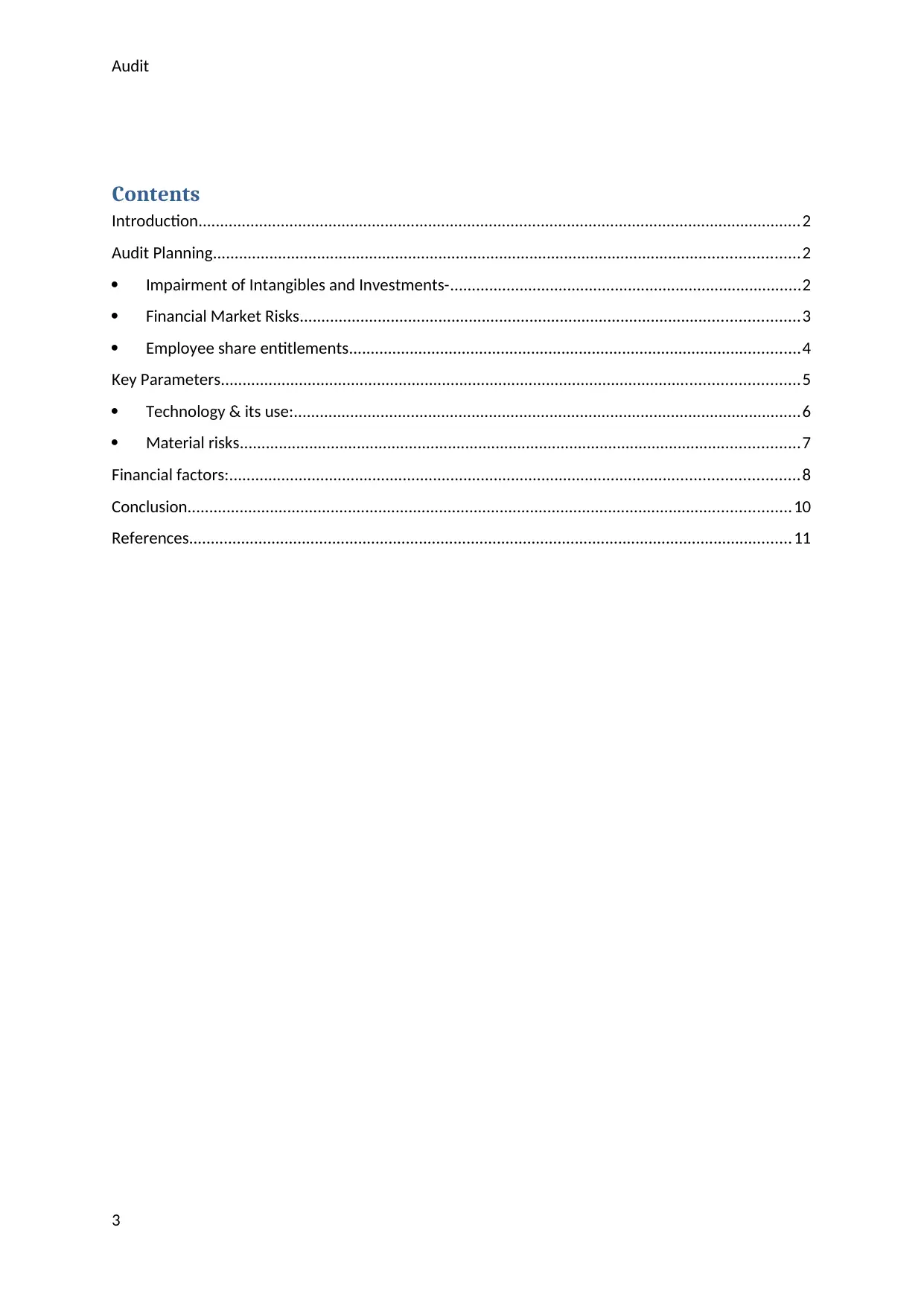
Audit
Contents
Introduction...........................................................................................................................................2
Audit Planning.......................................................................................................................................2
Impairment of Intangibles and Investments-.................................................................................2
Financial Market Risks...................................................................................................................3
Employee share entitlements........................................................................................................4
Key Parameters.....................................................................................................................................5
Technology & its use:.....................................................................................................................6
Material risks.................................................................................................................................7
Financial factors:...................................................................................................................................8
Conclusion...........................................................................................................................................10
References...........................................................................................................................................11
3
Contents
Introduction...........................................................................................................................................2
Audit Planning.......................................................................................................................................2
Impairment of Intangibles and Investments-.................................................................................2
Financial Market Risks...................................................................................................................3
Employee share entitlements........................................................................................................4
Key Parameters.....................................................................................................................................5
Technology & its use:.....................................................................................................................6
Material risks.................................................................................................................................7
Financial factors:...................................................................................................................................8
Conclusion...........................................................................................................................................10
References...........................................................................................................................................11
3
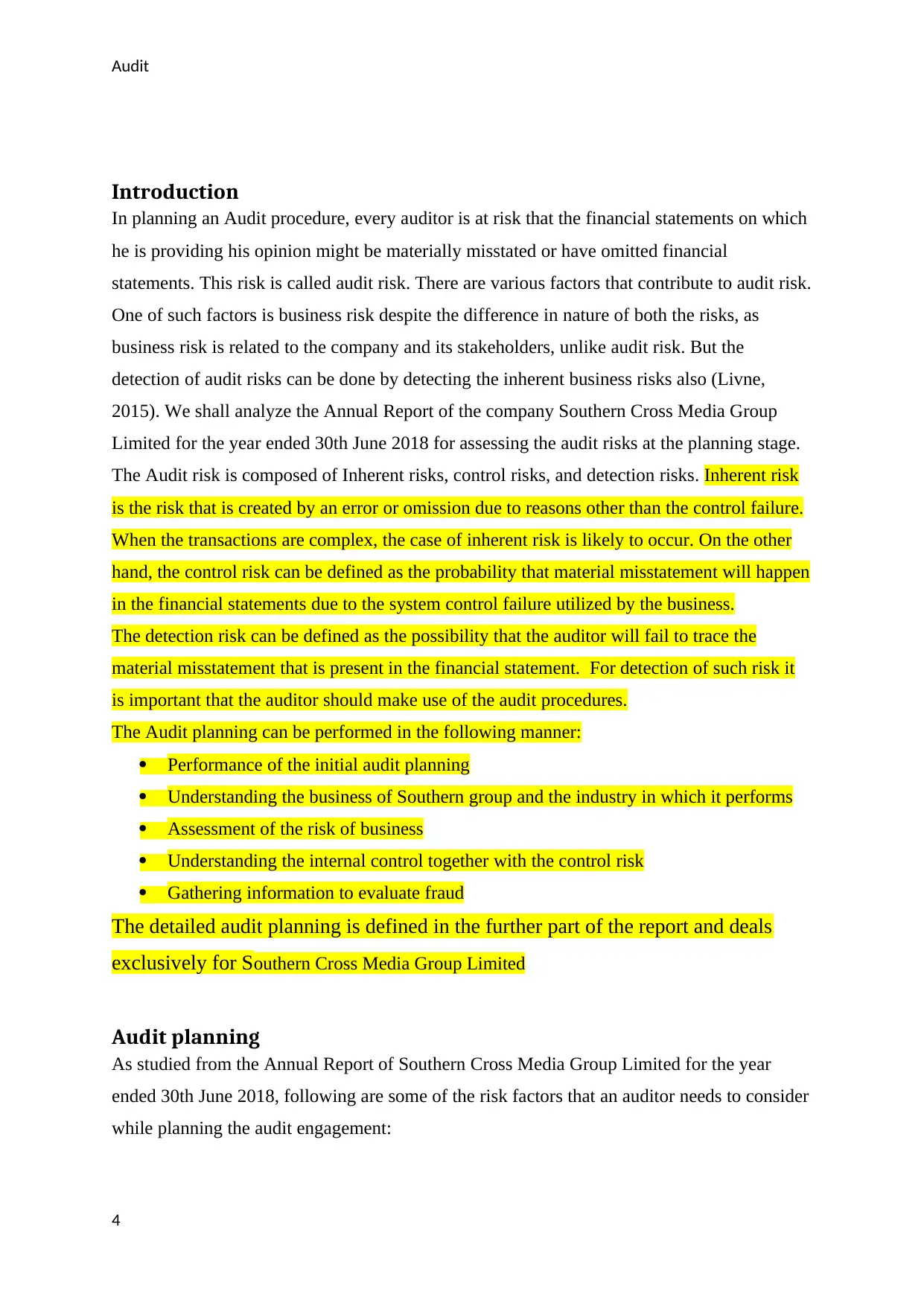
Audit
Introduction
In planning an Audit procedure, every auditor is at risk that the financial statements on which
he is providing his opinion might be materially misstated or have omitted financial
statements. This risk is called audit risk. There are various factors that contribute to audit risk.
One of such factors is business risk despite the difference in nature of both the risks, as
business risk is related to the company and its stakeholders, unlike audit risk. But the
detection of audit risks can be done by detecting the inherent business risks also (Livne,
2015). We shall analyze the Annual Report of the company Southern Cross Media Group
Limited for the year ended 30th June 2018 for assessing the audit risks at the planning stage.
The Audit risk is composed of Inherent risks, control risks, and detection risks. Inherent risk
is the risk that is created by an error or omission due to reasons other than the control failure.
When the transactions are complex, the case of inherent risk is likely to occur. On the other
hand, the control risk can be defined as the probability that material misstatement will happen
in the financial statements due to the system control failure utilized by the business.
The detection risk can be defined as the possibility that the auditor will fail to trace the
material misstatement that is present in the financial statement. For detection of such risk it
is important that the auditor should make use of the audit procedures.
The Audit planning can be performed in the following manner:
Performance of the initial audit planning
Understanding the business of Southern group and the industry in which it performs
Assessment of the risk of business
Understanding the internal control together with the control risk
Gathering information to evaluate fraud
The detailed audit planning is defined in the further part of the report and deals
exclusively for Southern Cross Media Group Limited
Audit planning
As studied from the Annual Report of Southern Cross Media Group Limited for the year
ended 30th June 2018, following are some of the risk factors that an auditor needs to consider
while planning the audit engagement:
4
Introduction
In planning an Audit procedure, every auditor is at risk that the financial statements on which
he is providing his opinion might be materially misstated or have omitted financial
statements. This risk is called audit risk. There are various factors that contribute to audit risk.
One of such factors is business risk despite the difference in nature of both the risks, as
business risk is related to the company and its stakeholders, unlike audit risk. But the
detection of audit risks can be done by detecting the inherent business risks also (Livne,
2015). We shall analyze the Annual Report of the company Southern Cross Media Group
Limited for the year ended 30th June 2018 for assessing the audit risks at the planning stage.
The Audit risk is composed of Inherent risks, control risks, and detection risks. Inherent risk
is the risk that is created by an error or omission due to reasons other than the control failure.
When the transactions are complex, the case of inherent risk is likely to occur. On the other
hand, the control risk can be defined as the probability that material misstatement will happen
in the financial statements due to the system control failure utilized by the business.
The detection risk can be defined as the possibility that the auditor will fail to trace the
material misstatement that is present in the financial statement. For detection of such risk it
is important that the auditor should make use of the audit procedures.
The Audit planning can be performed in the following manner:
Performance of the initial audit planning
Understanding the business of Southern group and the industry in which it performs
Assessment of the risk of business
Understanding the internal control together with the control risk
Gathering information to evaluate fraud
The detailed audit planning is defined in the further part of the report and deals
exclusively for Southern Cross Media Group Limited
Audit planning
As studied from the Annual Report of Southern Cross Media Group Limited for the year
ended 30th June 2018, following are some of the risk factors that an auditor needs to consider
while planning the audit engagement:
4
Secure Best Marks with AI Grader
Need help grading? Try our AI Grader for instant feedback on your assignments.
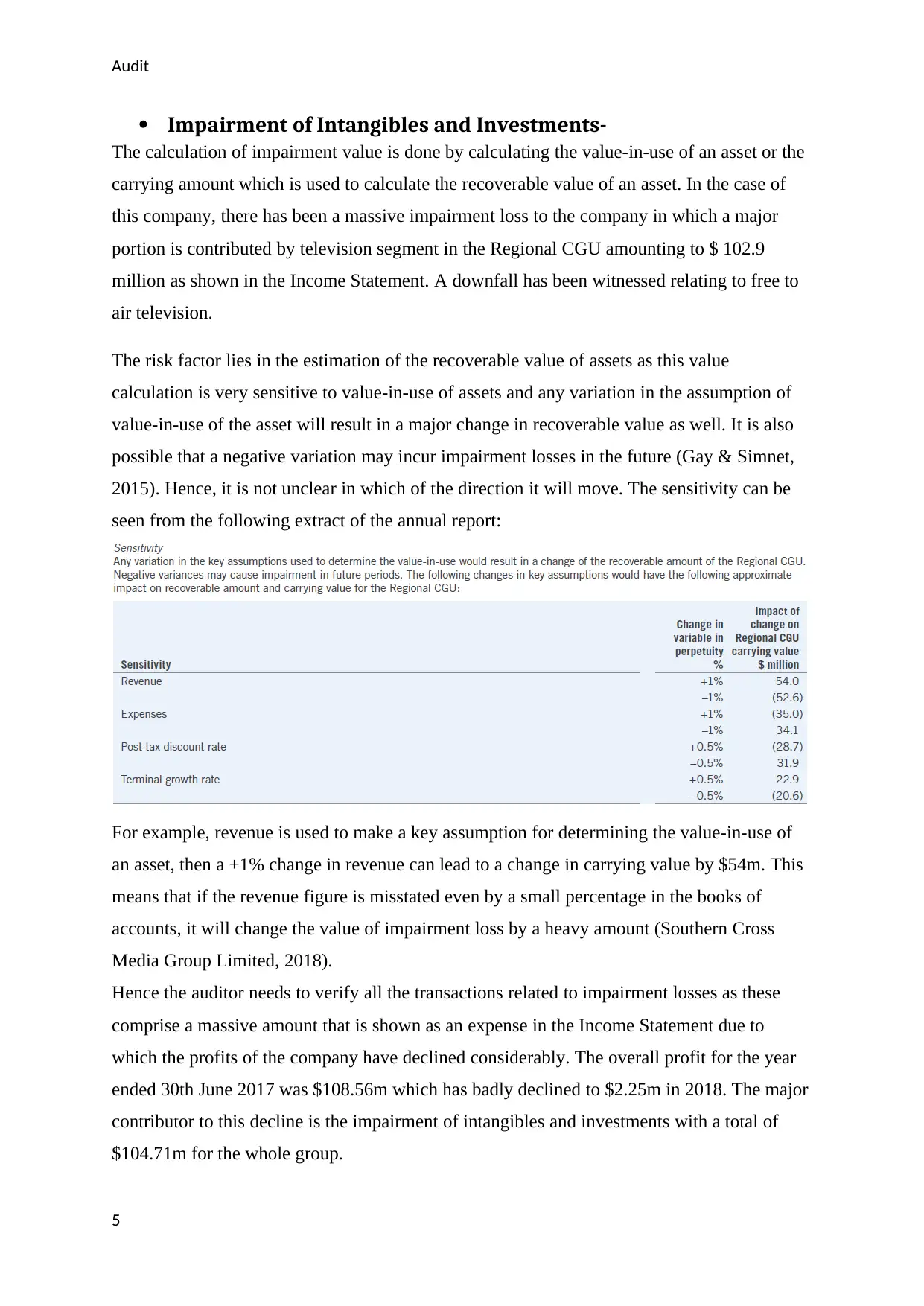
Audit
Impairment of Intangibles and Investments-
The calculation of impairment value is done by calculating the value-in-use of an asset or the
carrying amount which is used to calculate the recoverable value of an asset. In the case of
this company, there has been a massive impairment loss to the company in which a major
portion is contributed by television segment in the Regional CGU amounting to $ 102.9
million as shown in the Income Statement. A downfall has been witnessed relating to free to
air television.
The risk factor lies in the estimation of the recoverable value of assets as this value
calculation is very sensitive to value-in-use of assets and any variation in the assumption of
value-in-use of the asset will result in a major change in recoverable value as well. It is also
possible that a negative variation may incur impairment losses in the future (Gay & Simnet,
2015). Hence, it is not unclear in which of the direction it will move. The sensitivity can be
seen from the following extract of the annual report:
For example, revenue is used to make a key assumption for determining the value-in-use of
an asset, then a +1% change in revenue can lead to a change in carrying value by $54m. This
means that if the revenue figure is misstated even by a small percentage in the books of
accounts, it will change the value of impairment loss by a heavy amount (Southern Cross
Media Group Limited, 2018).
Hence the auditor needs to verify all the transactions related to impairment losses as these
comprise a massive amount that is shown as an expense in the Income Statement due to
which the profits of the company have declined considerably. The overall profit for the year
ended 30th June 2017 was $108.56m which has badly declined to $2.25m in 2018. The major
contributor to this decline is the impairment of intangibles and investments with a total of
$104.71m for the whole group.
5
Impairment of Intangibles and Investments-
The calculation of impairment value is done by calculating the value-in-use of an asset or the
carrying amount which is used to calculate the recoverable value of an asset. In the case of
this company, there has been a massive impairment loss to the company in which a major
portion is contributed by television segment in the Regional CGU amounting to $ 102.9
million as shown in the Income Statement. A downfall has been witnessed relating to free to
air television.
The risk factor lies in the estimation of the recoverable value of assets as this value
calculation is very sensitive to value-in-use of assets and any variation in the assumption of
value-in-use of the asset will result in a major change in recoverable value as well. It is also
possible that a negative variation may incur impairment losses in the future (Gay & Simnet,
2015). Hence, it is not unclear in which of the direction it will move. The sensitivity can be
seen from the following extract of the annual report:
For example, revenue is used to make a key assumption for determining the value-in-use of
an asset, then a +1% change in revenue can lead to a change in carrying value by $54m. This
means that if the revenue figure is misstated even by a small percentage in the books of
accounts, it will change the value of impairment loss by a heavy amount (Southern Cross
Media Group Limited, 2018).
Hence the auditor needs to verify all the transactions related to impairment losses as these
comprise a massive amount that is shown as an expense in the Income Statement due to
which the profits of the company have declined considerably. The overall profit for the year
ended 30th June 2017 was $108.56m which has badly declined to $2.25m in 2018. The major
contributor to this decline is the impairment of intangibles and investments with a total of
$104.71m for the whole group.
5
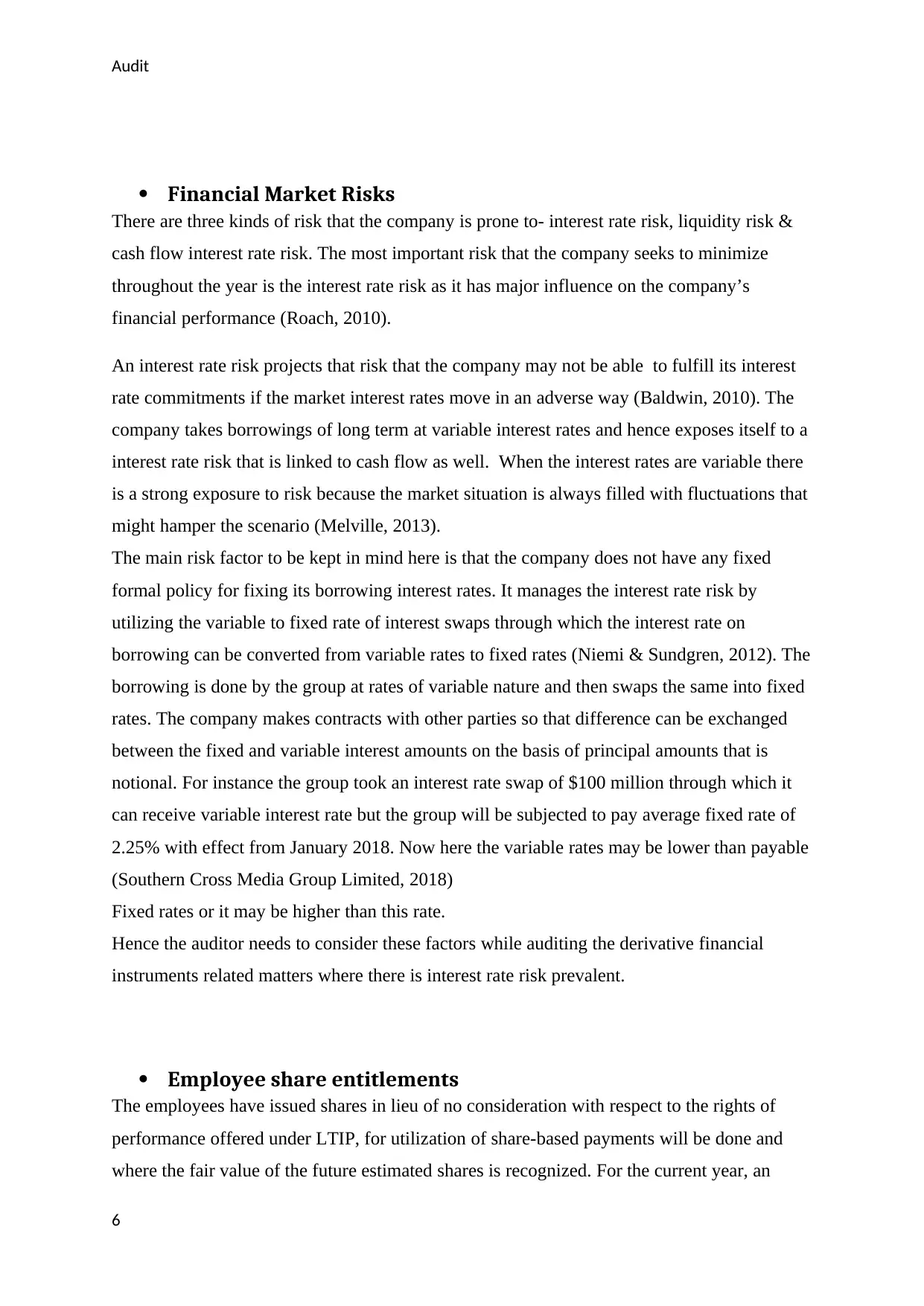
Audit
Financial Market Risks
There are three kinds of risk that the company is prone to- interest rate risk, liquidity risk &
cash flow interest rate risk. The most important risk that the company seeks to minimize
throughout the year is the interest rate risk as it has major influence on the company’s
financial performance (Roach, 2010).
An interest rate risk projects that risk that the company may not be able to fulfill its interest
rate commitments if the market interest rates move in an adverse way (Baldwin, 2010). The
company takes borrowings of long term at variable interest rates and hence exposes itself to a
interest rate risk that is linked to cash flow as well. When the interest rates are variable there
is a strong exposure to risk because the market situation is always filled with fluctuations that
might hamper the scenario (Melville, 2013).
The main risk factor to be kept in mind here is that the company does not have any fixed
formal policy for fixing its borrowing interest rates. It manages the interest rate risk by
utilizing the variable to fixed rate of interest swaps through which the interest rate on
borrowing can be converted from variable rates to fixed rates (Niemi & Sundgren, 2012). The
borrowing is done by the group at rates of variable nature and then swaps the same into fixed
rates. The company makes contracts with other parties so that difference can be exchanged
between the fixed and variable interest amounts on the basis of principal amounts that is
notional. For instance the group took an interest rate swap of $100 million through which it
can receive variable interest rate but the group will be subjected to pay average fixed rate of
2.25% with effect from January 2018. Now here the variable rates may be lower than payable
(Southern Cross Media Group Limited, 2018)
Fixed rates or it may be higher than this rate.
Hence the auditor needs to consider these factors while auditing the derivative financial
instruments related matters where there is interest rate risk prevalent.
Employee share entitlements
The employees have issued shares in lieu of no consideration with respect to the rights of
performance offered under LTIP, for utilization of share-based payments will be done and
where the fair value of the future estimated shares is recognized. For the current year, an
6
Financial Market Risks
There are three kinds of risk that the company is prone to- interest rate risk, liquidity risk &
cash flow interest rate risk. The most important risk that the company seeks to minimize
throughout the year is the interest rate risk as it has major influence on the company’s
financial performance (Roach, 2010).
An interest rate risk projects that risk that the company may not be able to fulfill its interest
rate commitments if the market interest rates move in an adverse way (Baldwin, 2010). The
company takes borrowings of long term at variable interest rates and hence exposes itself to a
interest rate risk that is linked to cash flow as well. When the interest rates are variable there
is a strong exposure to risk because the market situation is always filled with fluctuations that
might hamper the scenario (Melville, 2013).
The main risk factor to be kept in mind here is that the company does not have any fixed
formal policy for fixing its borrowing interest rates. It manages the interest rate risk by
utilizing the variable to fixed rate of interest swaps through which the interest rate on
borrowing can be converted from variable rates to fixed rates (Niemi & Sundgren, 2012). The
borrowing is done by the group at rates of variable nature and then swaps the same into fixed
rates. The company makes contracts with other parties so that difference can be exchanged
between the fixed and variable interest amounts on the basis of principal amounts that is
notional. For instance the group took an interest rate swap of $100 million through which it
can receive variable interest rate but the group will be subjected to pay average fixed rate of
2.25% with effect from January 2018. Now here the variable rates may be lower than payable
(Southern Cross Media Group Limited, 2018)
Fixed rates or it may be higher than this rate.
Hence the auditor needs to consider these factors while auditing the derivative financial
instruments related matters where there is interest rate risk prevalent.
Employee share entitlements
The employees have issued shares in lieu of no consideration with respect to the rights of
performance offered under LTIP, for utilization of share-based payments will be done and
where the fair value of the future estimated shares is recognized. For the current year, an
6
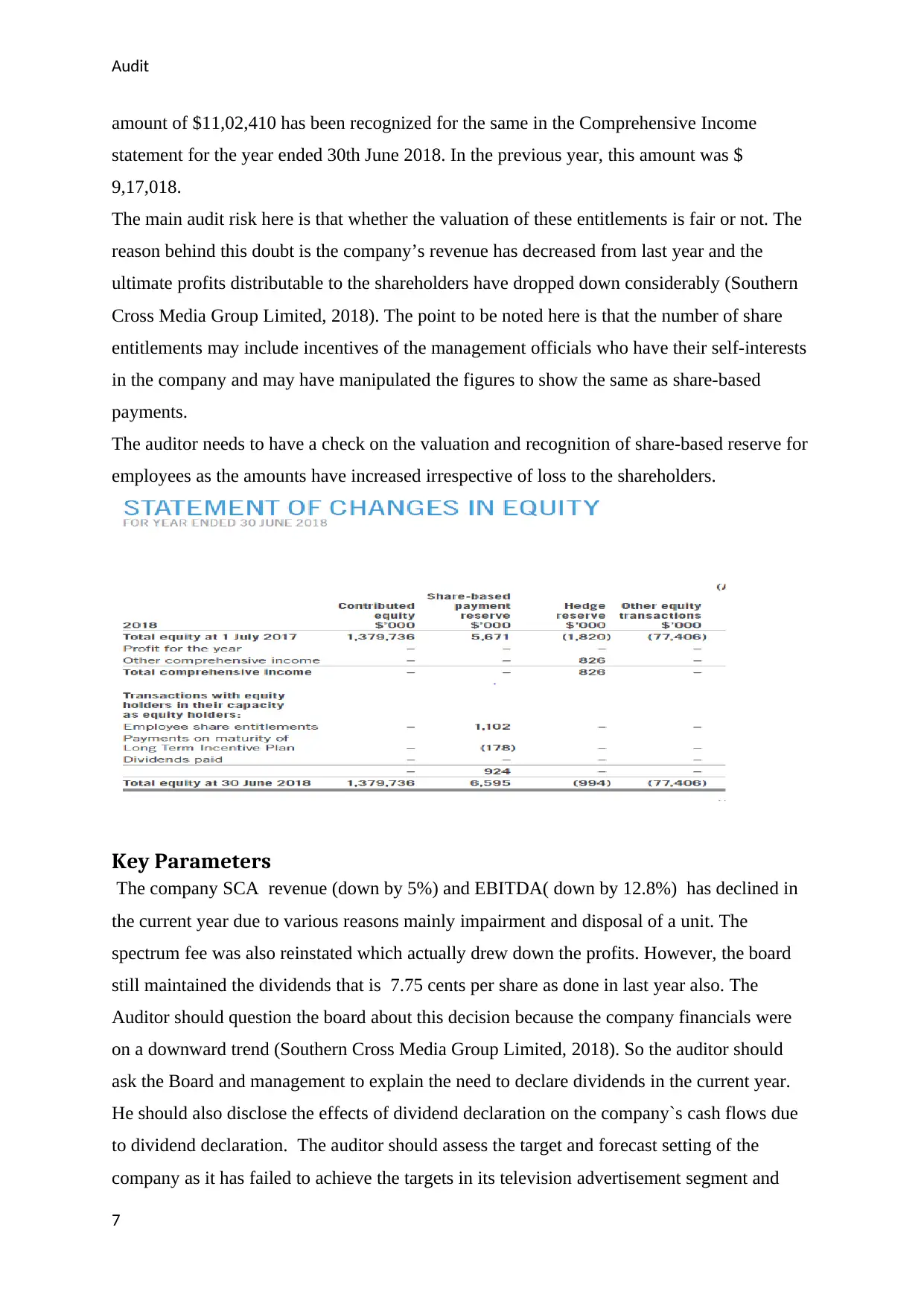
Audit
amount of $11,02,410 has been recognized for the same in the Comprehensive Income
statement for the year ended 30th June 2018. In the previous year, this amount was $
9,17,018.
The main audit risk here is that whether the valuation of these entitlements is fair or not. The
reason behind this doubt is the company’s revenue has decreased from last year and the
ultimate profits distributable to the shareholders have dropped down considerably (Southern
Cross Media Group Limited, 2018). The point to be noted here is that the number of share
entitlements may include incentives of the management officials who have their self-interests
in the company and may have manipulated the figures to show the same as share-based
payments.
The auditor needs to have a check on the valuation and recognition of share-based reserve for
employees as the amounts have increased irrespective of loss to the shareholders.
Key Parameters
The company SCA revenue (down by 5%) and EBITDA( down by 12.8%) has declined in
the current year due to various reasons mainly impairment and disposal of a unit. The
spectrum fee was also reinstated which actually drew down the profits. However, the board
still maintained the dividends that is 7.75 cents per share as done in last year also. The
Auditor should question the board about this decision because the company financials were
on a downward trend (Southern Cross Media Group Limited, 2018). So the auditor should
ask the Board and management to explain the need to declare dividends in the current year.
He should also disclose the effects of dividend declaration on the company`s cash flows due
to dividend declaration. The auditor should assess the target and forecast setting of the
company as it has failed to achieve the targets in its television advertisement segment and
7
amount of $11,02,410 has been recognized for the same in the Comprehensive Income
statement for the year ended 30th June 2018. In the previous year, this amount was $
9,17,018.
The main audit risk here is that whether the valuation of these entitlements is fair or not. The
reason behind this doubt is the company’s revenue has decreased from last year and the
ultimate profits distributable to the shareholders have dropped down considerably (Southern
Cross Media Group Limited, 2018). The point to be noted here is that the number of share
entitlements may include incentives of the management officials who have their self-interests
in the company and may have manipulated the figures to show the same as share-based
payments.
The auditor needs to have a check on the valuation and recognition of share-based reserve for
employees as the amounts have increased irrespective of loss to the shareholders.
Key Parameters
The company SCA revenue (down by 5%) and EBITDA( down by 12.8%) has declined in
the current year due to various reasons mainly impairment and disposal of a unit. The
spectrum fee was also reinstated which actually drew down the profits. However, the board
still maintained the dividends that is 7.75 cents per share as done in last year also. The
Auditor should question the board about this decision because the company financials were
on a downward trend (Southern Cross Media Group Limited, 2018). So the auditor should
ask the Board and management to explain the need to declare dividends in the current year.
He should also disclose the effects of dividend declaration on the company`s cash flows due
to dividend declaration. The auditor should assess the target and forecast setting of the
company as it has failed to achieve the targets in its television advertisement segment and
7
Paraphrase This Document
Need a fresh take? Get an instant paraphrase of this document with our AI Paraphraser
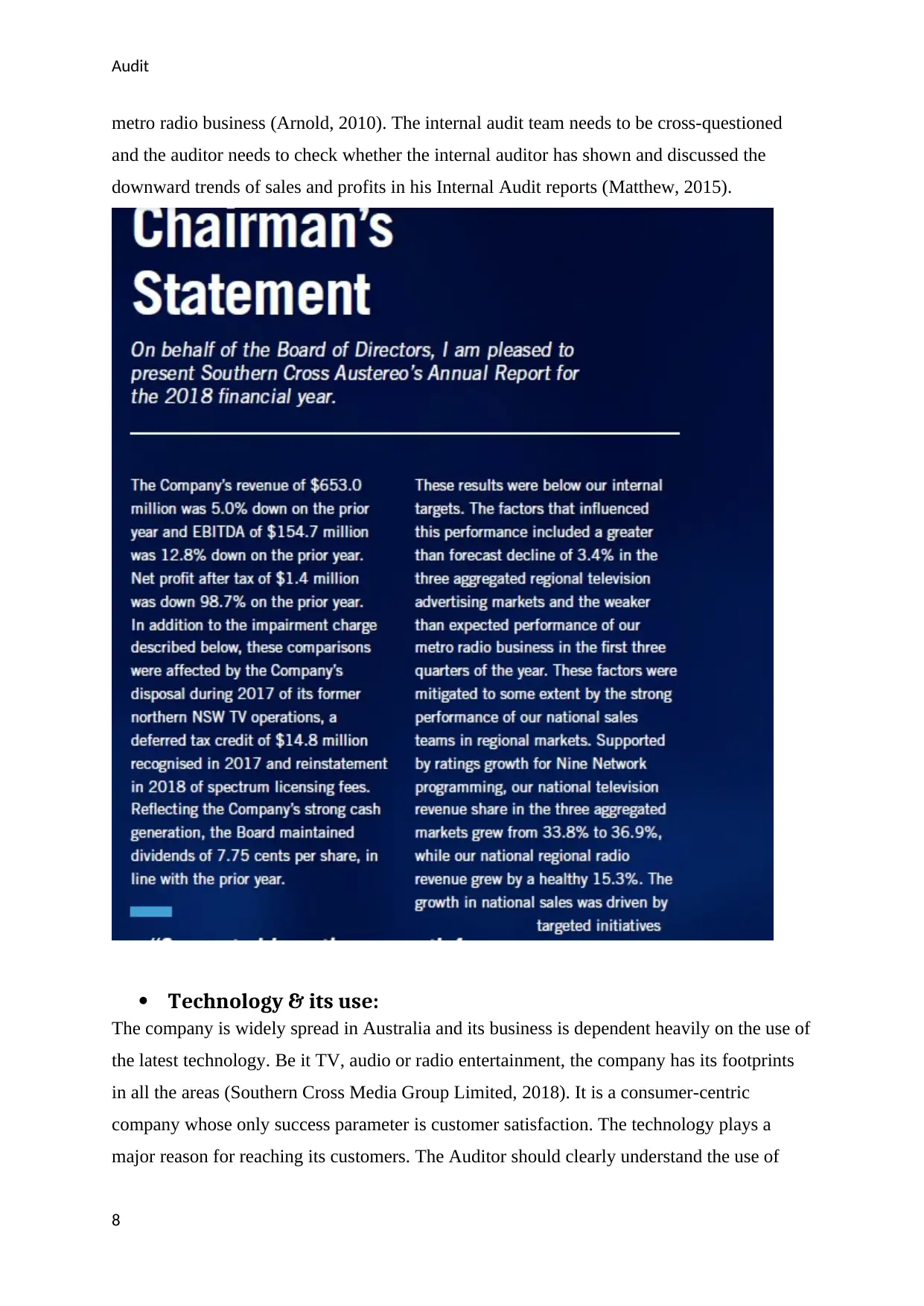
Audit
metro radio business (Arnold, 2010). The internal audit team needs to be cross-questioned
and the auditor needs to check whether the internal auditor has shown and discussed the
downward trends of sales and profits in his Internal Audit reports (Matthew, 2015).
Technology & its use:
The company is widely spread in Australia and its business is dependent heavily on the use of
the latest technology. Be it TV, audio or radio entertainment, the company has its footprints
in all the areas (Southern Cross Media Group Limited, 2018). It is a consumer-centric
company whose only success parameter is customer satisfaction. The technology plays a
major reason for reaching its customers. The Auditor should clearly understand the use of
8
metro radio business (Arnold, 2010). The internal audit team needs to be cross-questioned
and the auditor needs to check whether the internal auditor has shown and discussed the
downward trends of sales and profits in his Internal Audit reports (Matthew, 2015).
Technology & its use:
The company is widely spread in Australia and its business is dependent heavily on the use of
the latest technology. Be it TV, audio or radio entertainment, the company has its footprints
in all the areas (Southern Cross Media Group Limited, 2018). It is a consumer-centric
company whose only success parameter is customer satisfaction. The technology plays a
major reason for reaching its customers. The Auditor should clearly understand the use of
8
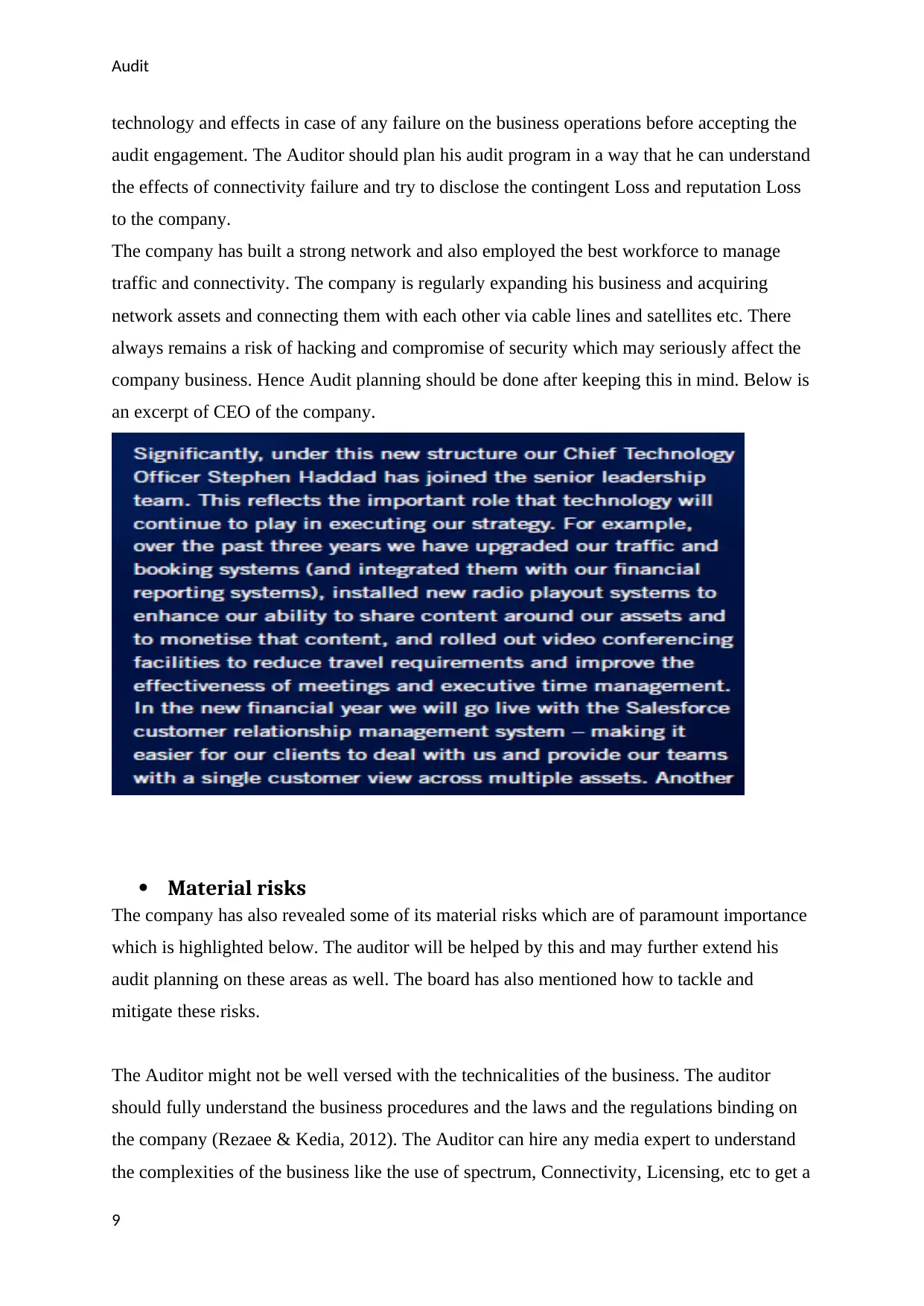
Audit
technology and effects in case of any failure on the business operations before accepting the
audit engagement. The Auditor should plan his audit program in a way that he can understand
the effects of connectivity failure and try to disclose the contingent Loss and reputation Loss
to the company.
The company has built a strong network and also employed the best workforce to manage
traffic and connectivity. The company is regularly expanding his business and acquiring
network assets and connecting them with each other via cable lines and satellites etc. There
always remains a risk of hacking and compromise of security which may seriously affect the
company business. Hence Audit planning should be done after keeping this in mind. Below is
an excerpt of CEO of the company.
Material risks
The company has also revealed some of its material risks which are of paramount importance
which is highlighted below. The auditor will be helped by this and may further extend his
audit planning on these areas as well. The board has also mentioned how to tackle and
mitigate these risks.
The Auditor might not be well versed with the technicalities of the business. The auditor
should fully understand the business procedures and the laws and the regulations binding on
the company (Rezaee & Kedia, 2012). The Auditor can hire any media expert to understand
the complexities of the business like the use of spectrum, Connectivity, Licensing, etc to get a
9
technology and effects in case of any failure on the business operations before accepting the
audit engagement. The Auditor should plan his audit program in a way that he can understand
the effects of connectivity failure and try to disclose the contingent Loss and reputation Loss
to the company.
The company has built a strong network and also employed the best workforce to manage
traffic and connectivity. The company is regularly expanding his business and acquiring
network assets and connecting them with each other via cable lines and satellites etc. There
always remains a risk of hacking and compromise of security which may seriously affect the
company business. Hence Audit planning should be done after keeping this in mind. Below is
an excerpt of CEO of the company.
Material risks
The company has also revealed some of its material risks which are of paramount importance
which is highlighted below. The auditor will be helped by this and may further extend his
audit planning on these areas as well. The board has also mentioned how to tackle and
mitigate these risks.
The Auditor might not be well versed with the technicalities of the business. The auditor
should fully understand the business procedures and the laws and the regulations binding on
the company (Rezaee & Kedia, 2012). The Auditor can hire any media expert to understand
the complexities of the business like the use of spectrum, Connectivity, Licensing, etc to get a
9
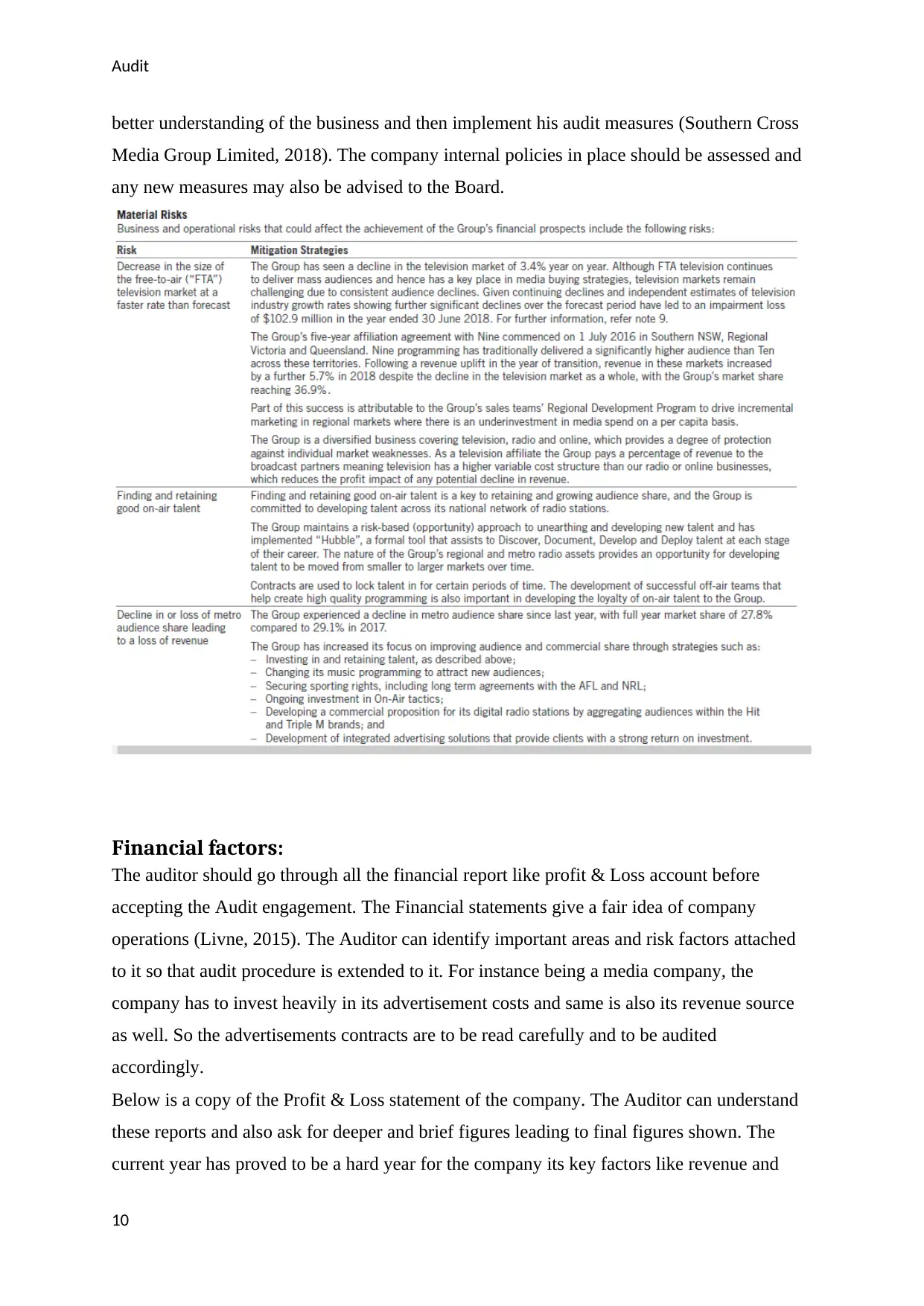
Audit
better understanding of the business and then implement his audit measures (Southern Cross
Media Group Limited, 2018). The company internal policies in place should be assessed and
any new measures may also be advised to the Board.
Financial factors:
The auditor should go through all the financial report like profit & Loss account before
accepting the Audit engagement. The Financial statements give a fair idea of company
operations (Livne, 2015). The Auditor can identify important areas and risk factors attached
to it so that audit procedure is extended to it. For instance being a media company, the
company has to invest heavily in its advertisement costs and same is also its revenue source
as well. So the advertisements contracts are to be read carefully and to be audited
accordingly.
Below is a copy of the Profit & Loss statement of the company. The Auditor can understand
these reports and also ask for deeper and brief figures leading to final figures shown. The
current year has proved to be a hard year for the company its key factors like revenue and
10
better understanding of the business and then implement his audit measures (Southern Cross
Media Group Limited, 2018). The company internal policies in place should be assessed and
any new measures may also be advised to the Board.
Financial factors:
The auditor should go through all the financial report like profit & Loss account before
accepting the Audit engagement. The Financial statements give a fair idea of company
operations (Livne, 2015). The Auditor can identify important areas and risk factors attached
to it so that audit procedure is extended to it. For instance being a media company, the
company has to invest heavily in its advertisement costs and same is also its revenue source
as well. So the advertisements contracts are to be read carefully and to be audited
accordingly.
Below is a copy of the Profit & Loss statement of the company. The Auditor can understand
these reports and also ask for deeper and brief figures leading to final figures shown. The
current year has proved to be a hard year for the company its key factors like revenue and
10
Secure Best Marks with AI Grader
Need help grading? Try our AI Grader for instant feedback on your assignments.
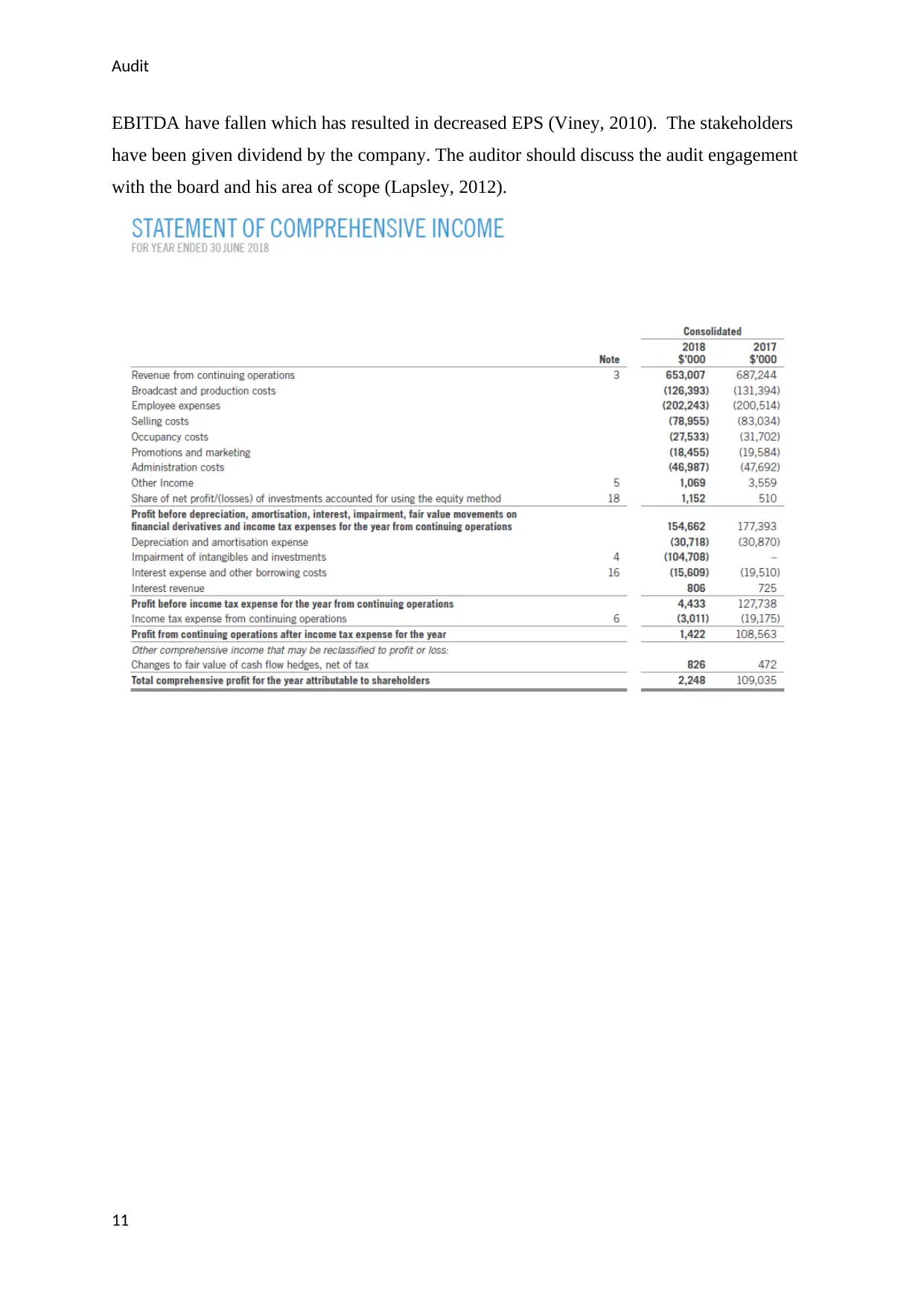
Audit
EBITDA have fallen which has resulted in decreased EPS (Viney, 2010). The stakeholders
have been given dividend by the company. The auditor should discuss the audit engagement
with the board and his area of scope (Lapsley, 2012).
11
EBITDA have fallen which has resulted in decreased EPS (Viney, 2010). The stakeholders
have been given dividend by the company. The auditor should discuss the audit engagement
with the board and his area of scope (Lapsley, 2012).
11
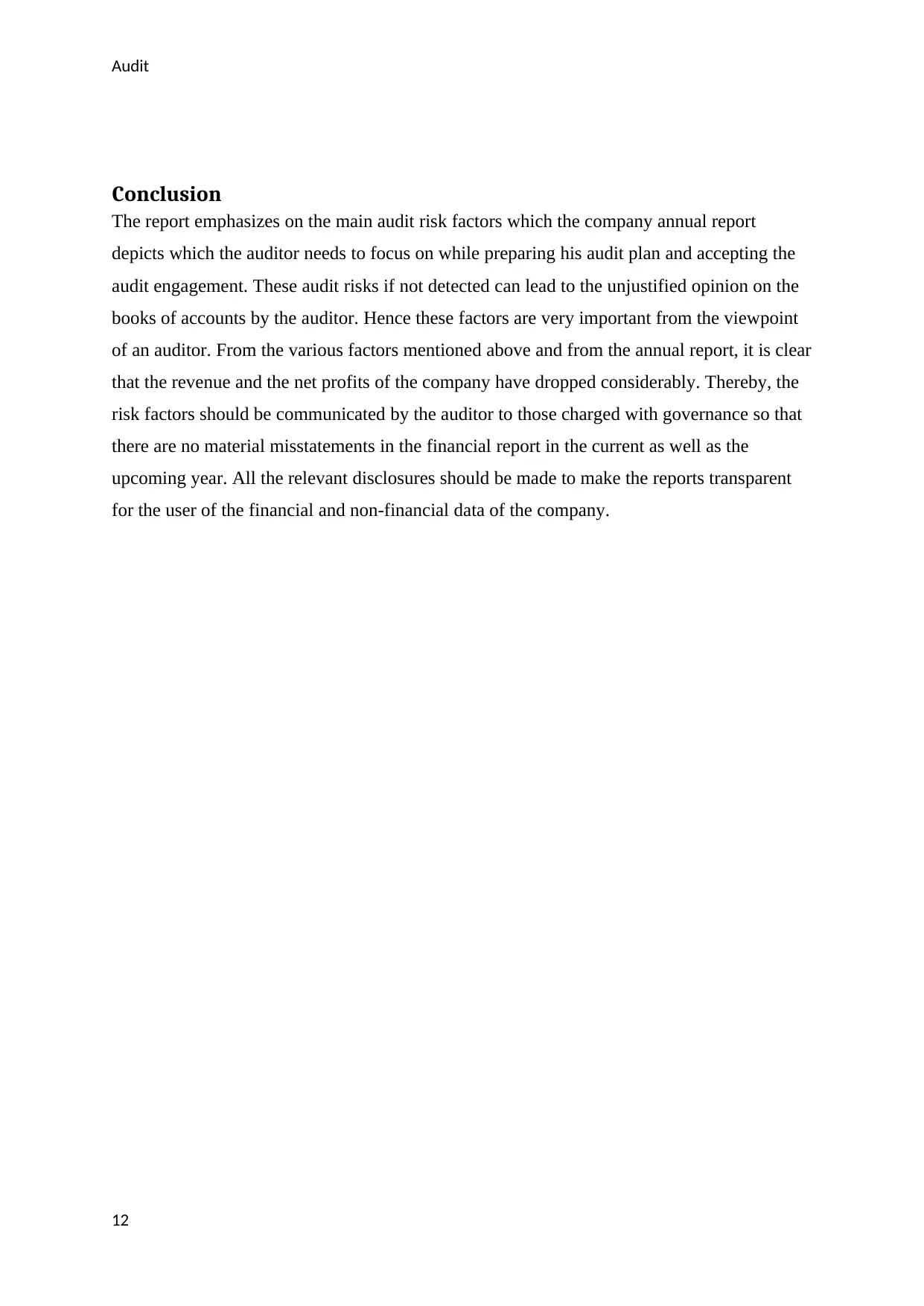
Audit
Conclusion
The report emphasizes on the main audit risk factors which the company annual report
depicts which the auditor needs to focus on while preparing his audit plan and accepting the
audit engagement. These audit risks if not detected can lead to the unjustified opinion on the
books of accounts by the auditor. Hence these factors are very important from the viewpoint
of an auditor. From the various factors mentioned above and from the annual report, it is clear
that the revenue and the net profits of the company have dropped considerably. Thereby, the
risk factors should be communicated by the auditor to those charged with governance so that
there are no material misstatements in the financial report in the current as well as the
upcoming year. All the relevant disclosures should be made to make the reports transparent
for the user of the financial and non-financial data of the company.
12
Conclusion
The report emphasizes on the main audit risk factors which the company annual report
depicts which the auditor needs to focus on while preparing his audit plan and accepting the
audit engagement. These audit risks if not detected can lead to the unjustified opinion on the
books of accounts by the auditor. Hence these factors are very important from the viewpoint
of an auditor. From the various factors mentioned above and from the annual report, it is clear
that the revenue and the net profits of the company have dropped considerably. Thereby, the
risk factors should be communicated by the auditor to those charged with governance so that
there are no material misstatements in the financial report in the current as well as the
upcoming year. All the relevant disclosures should be made to make the reports transparent
for the user of the financial and non-financial data of the company.
12
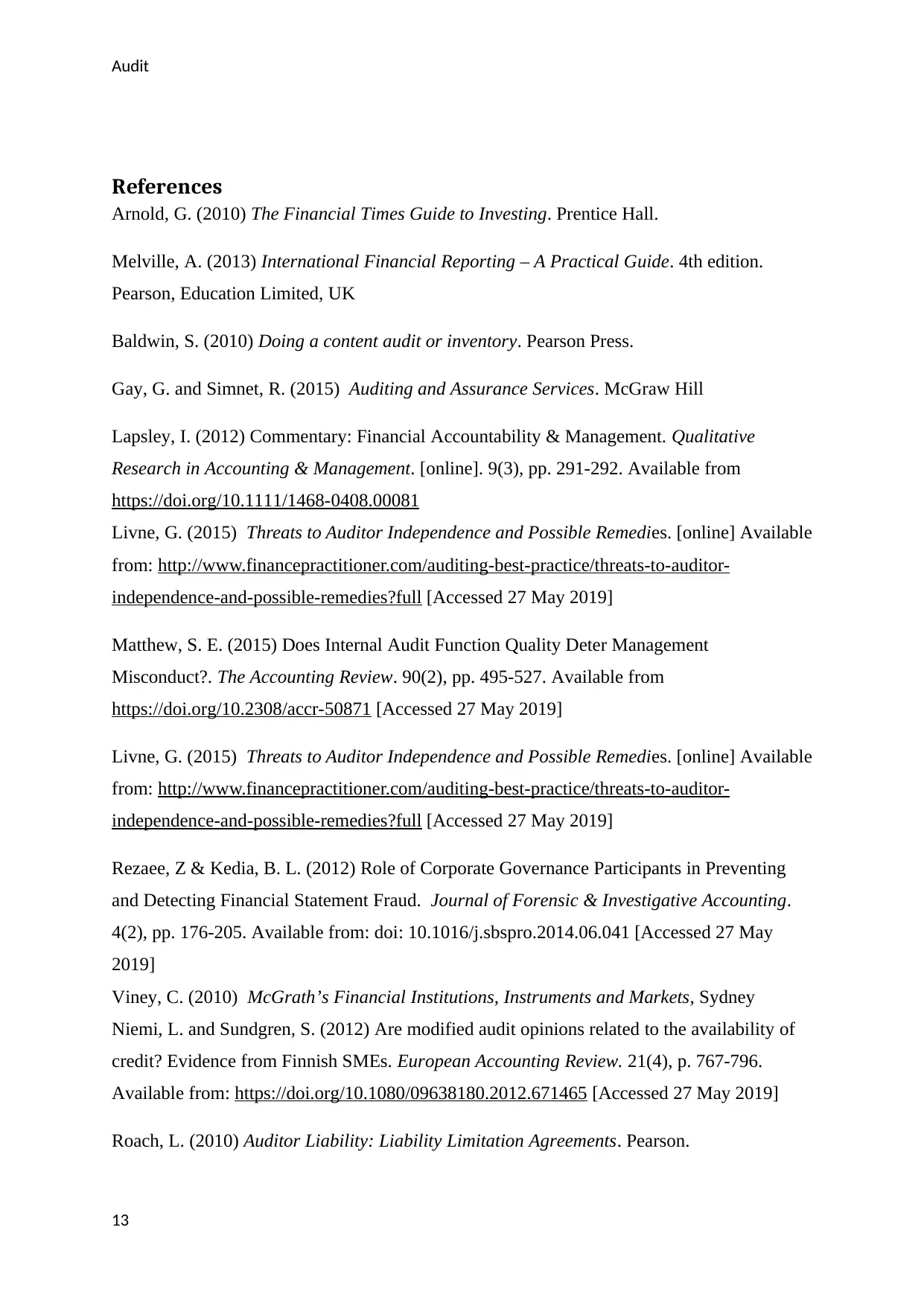
Audit
References
Arnold, G. (2010) The Financial Times Guide to Investing. Prentice Hall.
Melville, A. (2013) International Financial Reporting – A Practical Guide. 4th edition.
Pearson, Education Limited, UK
Baldwin, S. (2010) Doing a content audit or inventory. Pearson Press.
Gay, G. and Simnet, R. (2015) Auditing and Assurance Services. McGraw Hill
Lapsley, I. (2012) Commentary: Financial Accountability & Management. Qualitative
Research in Accounting & Management. [online]. 9(3), pp. 291-292. Available from
https://doi.org/10.1111/1468-0408.00081
Livne, G. (2015) Threats to Auditor Independence and Possible Remedies. [online] Available
from: http://www.financepractitioner.com/auditing-best-practice/threats-to-auditor-
independence-and-possible-remedies?full [Accessed 27 May 2019]
Matthew, S. E. (2015) Does Internal Audit Function Quality Deter Management
Misconduct?. The Accounting Review. 90(2), pp. 495-527. Available from
https://doi.org/10.2308/accr-50871 [Accessed 27 May 2019]
Livne, G. (2015) Threats to Auditor Independence and Possible Remedies. [online] Available
from: http://www.financepractitioner.com/auditing-best-practice/threats-to-auditor-
independence-and-possible-remedies?full [Accessed 27 May 2019]
Rezaee, Z & Kedia, B. L. (2012) Role of Corporate Governance Participants in Preventing
and Detecting Financial Statement Fraud. Journal of Forensic & Investigative Accounting.
4(2), pp. 176-205. Available from: doi: 10.1016/j.sbspro.2014.06.041 [Accessed 27 May
2019]
Viney, C. (2010) McGrath’s Financial Institutions, Instruments and Markets, Sydney
Niemi, L. and Sundgren, S. (2012) Are modified audit opinions related to the availability of
credit? Evidence from Finnish SMEs. European Accounting Review. 21(4), p. 767-796.
Available from: https://doi.org/10.1080/09638180.2012.671465 [Accessed 27 May 2019]
Roach, L. (2010) Auditor Liability: Liability Limitation Agreements. Pearson.
13
References
Arnold, G. (2010) The Financial Times Guide to Investing. Prentice Hall.
Melville, A. (2013) International Financial Reporting – A Practical Guide. 4th edition.
Pearson, Education Limited, UK
Baldwin, S. (2010) Doing a content audit or inventory. Pearson Press.
Gay, G. and Simnet, R. (2015) Auditing and Assurance Services. McGraw Hill
Lapsley, I. (2012) Commentary: Financial Accountability & Management. Qualitative
Research in Accounting & Management. [online]. 9(3), pp. 291-292. Available from
https://doi.org/10.1111/1468-0408.00081
Livne, G. (2015) Threats to Auditor Independence and Possible Remedies. [online] Available
from: http://www.financepractitioner.com/auditing-best-practice/threats-to-auditor-
independence-and-possible-remedies?full [Accessed 27 May 2019]
Matthew, S. E. (2015) Does Internal Audit Function Quality Deter Management
Misconduct?. The Accounting Review. 90(2), pp. 495-527. Available from
https://doi.org/10.2308/accr-50871 [Accessed 27 May 2019]
Livne, G. (2015) Threats to Auditor Independence and Possible Remedies. [online] Available
from: http://www.financepractitioner.com/auditing-best-practice/threats-to-auditor-
independence-and-possible-remedies?full [Accessed 27 May 2019]
Rezaee, Z & Kedia, B. L. (2012) Role of Corporate Governance Participants in Preventing
and Detecting Financial Statement Fraud. Journal of Forensic & Investigative Accounting.
4(2), pp. 176-205. Available from: doi: 10.1016/j.sbspro.2014.06.041 [Accessed 27 May
2019]
Viney, C. (2010) McGrath’s Financial Institutions, Instruments and Markets, Sydney
Niemi, L. and Sundgren, S. (2012) Are modified audit opinions related to the availability of
credit? Evidence from Finnish SMEs. European Accounting Review. 21(4), p. 767-796.
Available from: https://doi.org/10.1080/09638180.2012.671465 [Accessed 27 May 2019]
Roach, L. (2010) Auditor Liability: Liability Limitation Agreements. Pearson.
13
Paraphrase This Document
Need a fresh take? Get an instant paraphrase of this document with our AI Paraphraser
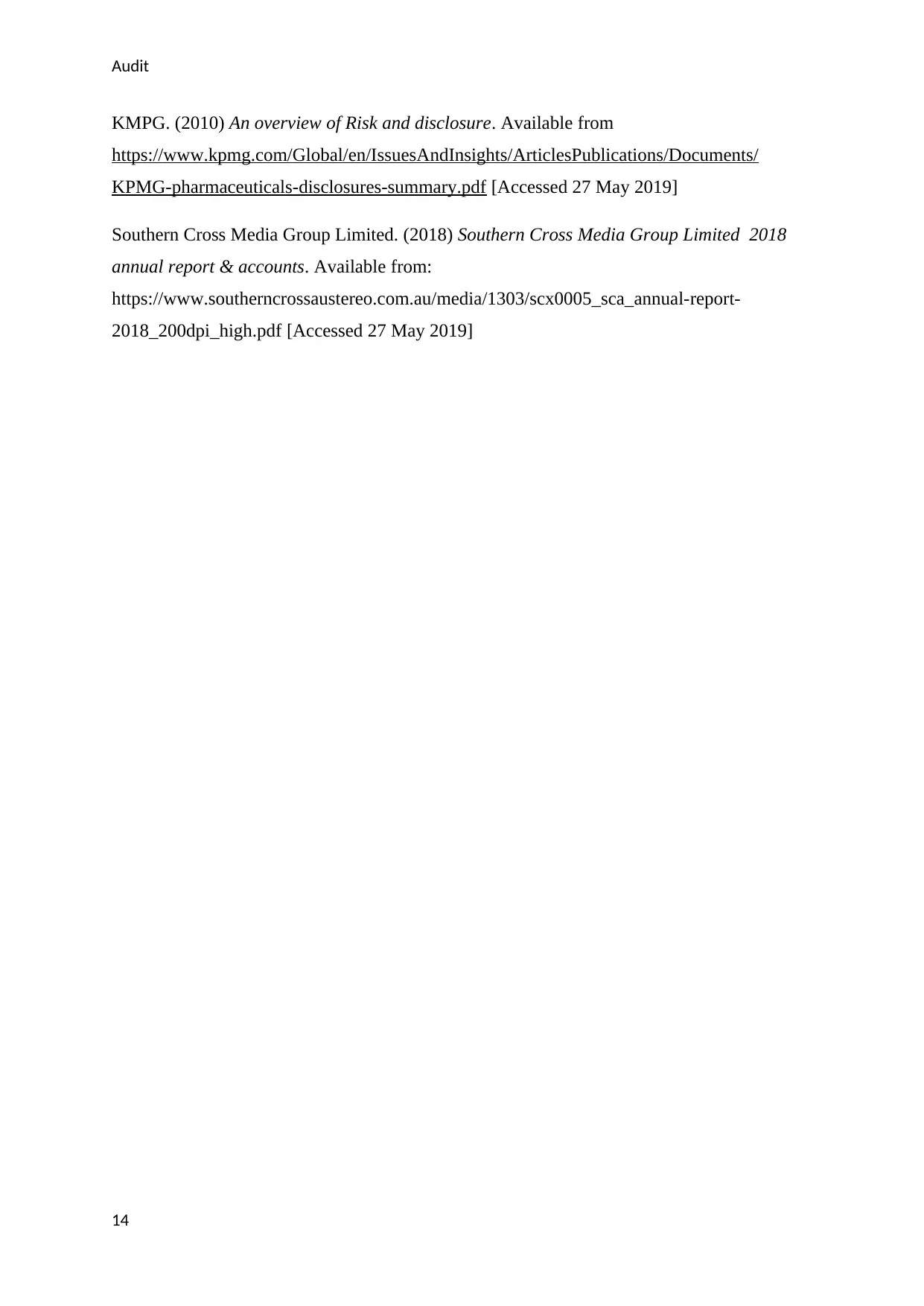
Audit
KMPG. (2010) An overview of Risk and disclosure. Available from
https://www.kpmg.com/Global/en/IssuesAndInsights/ArticlesPublications/Documents/
KPMG-pharmaceuticals-disclosures-summary.pdf [Accessed 27 May 2019]
Southern Cross Media Group Limited. (2018) Southern Cross Media Group Limited 2018
annual report & accounts. Available from:
https://www.southerncrossaustereo.com.au/media/1303/scx0005_sca_annual-report-
2018_200dpi_high.pdf [Accessed 27 May 2019]
14
KMPG. (2010) An overview of Risk and disclosure. Available from
https://www.kpmg.com/Global/en/IssuesAndInsights/ArticlesPublications/Documents/
KPMG-pharmaceuticals-disclosures-summary.pdf [Accessed 27 May 2019]
Southern Cross Media Group Limited. (2018) Southern Cross Media Group Limited 2018
annual report & accounts. Available from:
https://www.southerncrossaustereo.com.au/media/1303/scx0005_sca_annual-report-
2018_200dpi_high.pdf [Accessed 27 May 2019]
14
1 out of 14
Related Documents
Your All-in-One AI-Powered Toolkit for Academic Success.
+13062052269
info@desklib.com
Available 24*7 on WhatsApp / Email
![[object Object]](/_next/static/media/star-bottom.7253800d.svg)
Unlock your academic potential
© 2024 | Zucol Services PVT LTD | All rights reserved.




